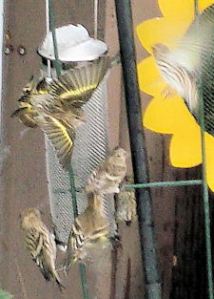Inspired by Pat’s recent post about birding the irrigation canal in Calgary, I headed down last week to check it out. I started at the bridge on Gosling Way by the Inglewood Golf Course in southeast Calgary and headed south. I often bird this area in the summer, but I’ve never been there in the fall after the water flow is stopped in September. Trout Unlimited did their annual Fish rescue near the Max Bell arena on September 30. They remove a lot of the larger fish, which would die in the winter, but there are many small fish left in the canal. There is still quite a bit of standing water, and some mudflats and exposed mats of vegetation.

The Canal near the Inglewood Golf Course
On the canal I saw several Mallards and Ring-billed Gulls, one Blue-winged Teal, one Common Goldeneye, and six Greater Yellowlegs. The yellowlegs would occasionally catch small fish. Also hunting in the water was a juvenile Great Blue Heron. A man who walks there every day told me that the heron had been there daily for about three weeks. He also saw a lone swan there about two weeks previously – the only one he has ever seen in the canal. I’m not sure if there was enough water now for a swan to be able to take off.

Juvenile Great Blue Heron
There was one Merlin in the trees on the west side of the canal, which took a run at a squirrel and then chased off a harassing magpie. Bald Eagles nest on the golf course and have overwintered here for the past few years, but I didn’t see them that day. As I walked south (still only about 100 metres from the bridge), I came across a group of eight Common Mergansers and two groups of Hooded Mergansers, twelve in all, including five adult males.

Hooded Mergansers, conveniently demonstrating 3 different positions of their crests.
On the way back, some new birds had arrived. There were three Long-billed Dowitchers feeding in the canal (very late migrants), and then a group of six Rusty Blackbirds on the mudflats. These birds are not very common, and these were the first ones I’ve ever seen.
I returned to the canal on the weekend to get some photos and see what was new. Most of the same bird species were there, plus one male Redhead.

Redhead (right) with female Hooded Merganser.
I also walked north from the bridge to the source of the canal north of the Max Bell arena. There were Mallards, Ring-billed Gulls, Canada Geese, and a muskrat building a lodge in the middle of the canal. I’m not sure how he’ll make out when it gets colder – he’ll probably have to move to the open water on the river.

Muskrat at lodge.
The canal is a great place for fall birds, and seems to get some late migrants. Lately it has been freezing over at night, and there are birds there only on warm afternoons.
The canal stretches east for many miles, so there is a lot to explore. It is also a good location to do Non-Motorized Transport birding, since there is a paved pathway running alongside it. In the summer I have ridden my bike all the way to Lake Chestermere (25 kms) and back, birding all the way.













 The Royal Society for the Protection of Birds (RSPB) in the UK has proclaimed October 24 as Feed The Birds Day. It serves as a reminder of all the things we can do to help the birds through the coming winter.
The Royal Society for the Protection of Birds (RSPB) in the UK has proclaimed October 24 as Feed The Birds Day. It serves as a reminder of all the things we can do to help the birds through the coming winter.



